Time Citroen C4 AIRCROSS 2014 1.G Owner's Guide
[x] Cancel search | Manufacturer: CITROEN, Model Year: 2014, Model line: C4 AIRCROSS, Model: Citroen C4 AIRCROSS 2014 1.GPages: 368, PDF Size: 20.37 MB
Page 117 of 368

115
4
Driving
This gearbox has two driving modes:
- an automated mode for automatic control
of the gears by the gearbox and therefore
without any action on the part of the driver,
- a manual mode for sequential changing of
the gears by the driver using the steering
mounted controls or the gear lever.
CVT gearbox
It includes the following controls:
- a gear lever 1
on the centre console for
selecting the driving mode, reverse gear
and neutral or for changing gear in manual
mode,
- a "-"
steering mounted control paddle 2
for
manual downward gear changes,
- a "+/OFF"
steering mounted control
paddle 3
for manual upward gear changes.
The six-speed automatic gearbox offers a choice between the comfort of automatic regulation or the pleasure of manual gear changing.
The mode can be changed at any time.
Page 120 of 368
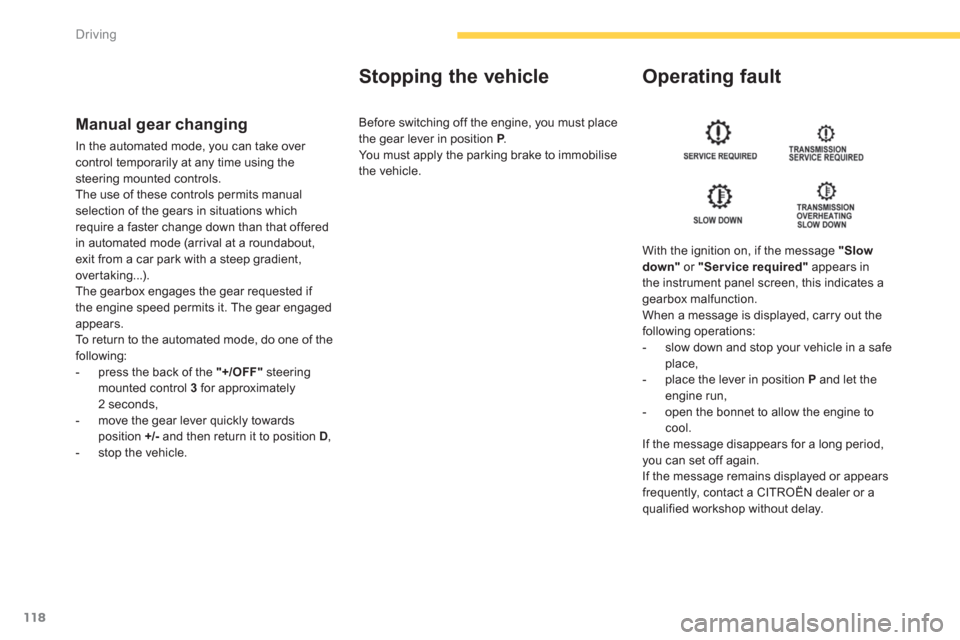
118Driving
Manual gear changing
In the automated mode, you can take over
control temporarily at any time using the
steering mounted controls.
The use of these controls permits manual
selection of the gears in situations which
require a faster change down than that offered
in automated mode (arrival at a roundabout,
exit from a car park with a steep gradient,
over taking...).
The gearbox engages the gear requested if
the engine speed permits it. The gear engaged
appears.
To return to the automated mode, do one of the
following:
- press the back of the "+/OFF"
steering
mounted control 3
for approximately
2 seconds,
- move the gear lever quickly towards
position +/-
and then return it to position D
,
- stop the vehicle.
Stopping the vehicle
Operating fault
With the ignition on, if the message "Slow
down"
or "Service required"
appears in
the instrument panel screen, this indicates a
gearbox malfunction.
When a message is displayed, carry out the
following operations:
- slow down and stop your vehicle in a safe
place,
- place the lever in position P
and let the
engine run,
- open the bonnet to allow the engine to
cool.
If the message disappears for a long period,
you can set off again.
If the message remains displayed or appears
frequently, contact a CITROËN dealer or a
qualified workshop without delay. Before switching off the engine, you must place
the gear lever in position P
.
You must apply the parking brake to immobilise
the vehicle.
Page 122 of 368
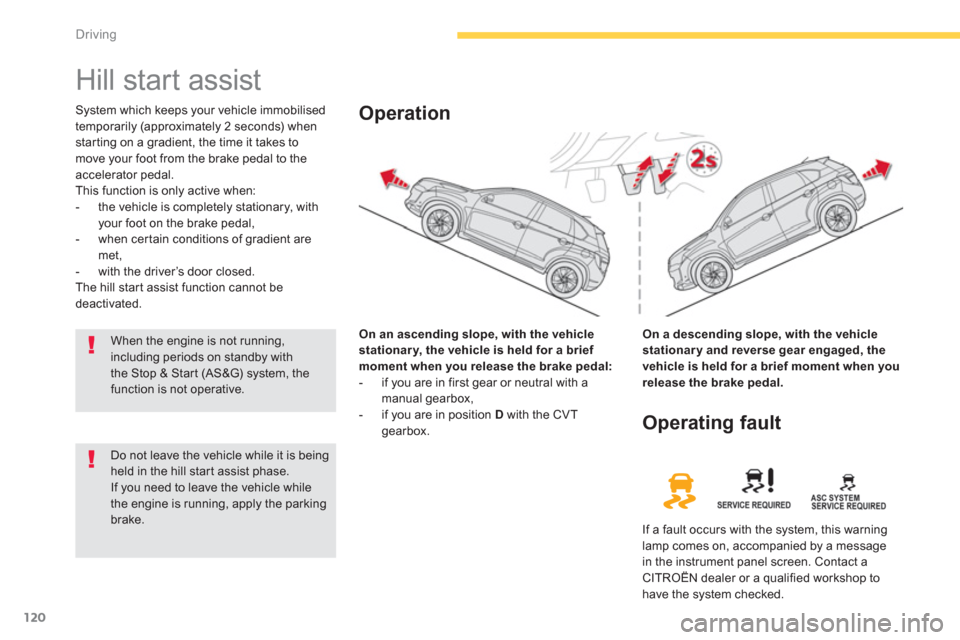
120
Driving
Hill start assist
System which keeps your vehicle immobilised
temporarily (approximately 2 seconds) when
starting on a gradient, the time it takes to
move your foot from the brake pedal to the
accelerator pedal.
This function is only active when:
- the vehicle is completely stationary, with
your foot on the brake pedal,
- when certain conditions of gradient are
met,
- with the driver’s door closed.
The hill start assist function cannot be
deactivated.
On an ascending slope, with the vehicle
stationar y, the vehicle is held for a brief
moment when you release the brake pedal:
- if you are in first gear or neutral with a
manual gearbox,
- if you are in position D
with the CVT
gearbox.
Operation
On a descending slope, with the vehicle
stationar y and reverse gear engaged, the
vehicle is held for a brief moment when you
release the brake pedal.
Do not leave the vehicle while it is being
held in the hill start assist phase.
If you need to leave the vehicle while
the engine is running, apply the parking
brake.
Operating fault
If a fault occurs with the system, this warning
lamp comes on, accompanied by a message
in the instrument panel screen. Contact a
CITROËN dealer or a qualified workshop to
have the system checked.
When the engine is not running,
including periods on standby with
the Stop & Start (AS&G) system, the
function is not operative.
Page 124 of 368

122
Driving
Going into engine START mode
The "AS &G"
warning lamp goes off
and the engine starts automatically:
- with a manual gearbox
, when you fully
depress the clutch pedal.
For safety reasons or to ensure smooth
operation, START mode is invoked
automatically when:
Special cases: START invoked
automatically
- the speed of the vehicle exceeds 2 mph
(3 km/h),
- some special conditions (battery charge,
engine temperature, braking assistance,
ambient temperature...) where the engine is
needed to assure control of a system.
If the system has been deactivated in
STOP mode, the engine will not start. At any time, press the "AS &G O FF "
switch to
deactivate the system.
Deactivation
In this case the "AS &G"
warning lamp
flashes for few seconds, then goes off.
This operation is per fectly normal.
This is confirmed by the "AS &G O FF "
warning lamp coming on in the instrument
panel or instrument panel screen.
Page 127 of 368
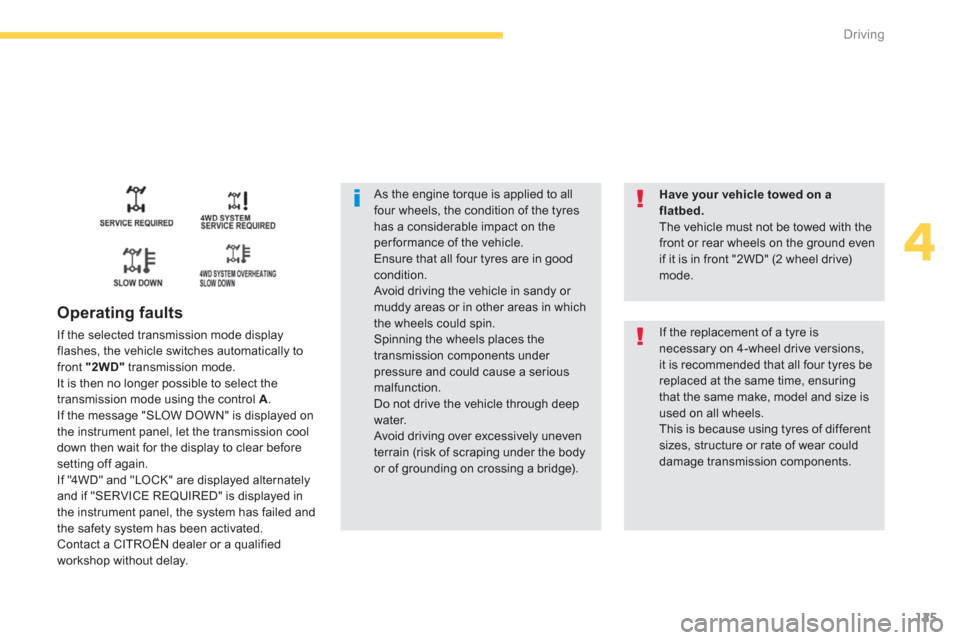
125
4
Driving
As the engine torque is applied to all
four wheels, the condition of the tyres
has a considerable impact on the
per formance of the vehicle.
Ensure that all four tyres are in good
condition.
Avoid driving the vehicle in sandy or
muddy areas or in other areas in which
the wheels could spin.
Spinning the wheels places the
transmission components under
pressure and could cause a serious
malfunction.
Do not drive the vehicle through deep
water.
Avoid driving over excessively uneven
terrain (risk of scraping under the body
or of grounding on crossing a bridge).
Operating faults
If the selected transmission mode display
flashes, the vehicle switches automatically to
front "2WD"
transmission mode.
It is then no longer possible to select the
transmission mode using the control A
.
If the message "SLOW DOWN" is displayed on
the instrument panel, let the transmission cool
down then wait for the display to clear before
setting off again.
If "4WD" and "LOCK" are displayed alternately
and if "SERVICE REQUIRED" is displayed in
the instrument panel, the system has failed and
the safety system has been activated.
Contact a CITROËN dealer or a qualified
workshop without delay.
Have your vehicle towed on a
flatbed.
The vehicle must not be towed with the
front or rear wheels on the ground even
if it is in front "2WD" (2 wheel drive)
mode.
If the replacement of a tyre is
necessary on 4-wheel drive versions,
it is recommended that all four tyres be
replaced at the same time, ensuring
that the same make, model and size is
used on all wheels.
This is because using tyres of different
sizes, structure or rate of wear could
damage transmission components.
Page 131 of 368

129
4
Driving
Parking sensors
This function cannot, in any
circumstances, take the place of the
vigilance and responsibility of the driver.
Rear parking sensors
This system indicates the proximity of an
obstacle (person, vehicle, tree, gate, etc.)
which comes within the field of detection of
sensors located in the bumper.
Certain types of obstacle (stake, roadworks
cone, etc.) detected initially will no longer be
detected at the end of the manoeuvre due to
the presence of blind spots.
Audible assistance
The proximity information is given by an
intermittent audible signal, the frequency of
which increases as the vehicle approaches the
obstacle.
When the distance between the vehicle and
the obstacle becomes less than approximately
thirty centimetres, the audible signal becomes
continuous.
The system is switched on by engaging reverse
gear. This is accompanied by an audible signal.
The indicator lamp in the button comes on to
confirm that the system is active.
The system is deactivated when you come out
of reverse gear.
Page 135 of 368

133
5
Visibility
Lighting controls
Stalk for selecting and switching the vehicle's
front and rear exterior lamps.
Main lighting
The various front and rear lamps of the vehicle
are designed to adapt the lighting progressively
in relation to the climatic conditions and so
ensure the best visibility for the driver:
- sidelamps, to be seen,
- dipped beam headlamps to see without
dazzling other drivers,
- main beam headlamps to see clearly when
the road is clear.
Additional lighting
Other lamps are provided to fulfil the
requirements of particular driving conditions:
- a rear foglamp to be seen from a distance,
- front foglamps for even better visibility,
- daytime running lamps to be seen during
the day.
In some weather conditions (e.g. low
temperature or humidity), the presence
of misting on the internal sur face of the
glass of the headlamps and rear lamps
is normal; it disappears after the lamps
have been on for a few minutes.
Other lighting functions are also available:
- automatic illumination of
headlamps,
- guide-me-home lighting,
- welcome lighting.
Travelling abroad
If using your vehicle in a country that
drives on the other side of the road, the
headlamps must be adjusted to avoid
dazzling on-coming drivers.
Contact a CITROËN dealer or a
qualified workshop.
Page 136 of 368
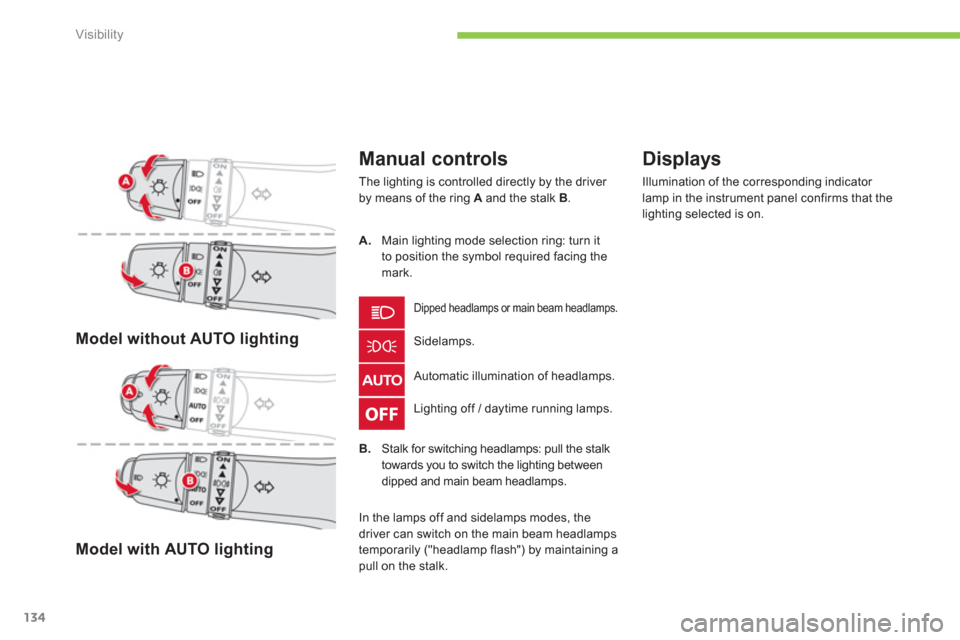
134
Visibility
Model without AUTO lighting
Model with AUTO lighting
Manual controls
The lighting is controlled directly by the driver
by means of the ring A
and the stalk B
.
Lighting off / daytime running lamps.
Automatic illumination of headlamps. Sidelamps.
Dipped headlamps or main beam headlamps.
Displays
Illumination of the corresponding indicator
lamp in the instrument panel confirms that the
lighting selected is on.
A.
Main lighting mode selection ring: turn it
to position the symbol required facing the
mark.
B.
Stalk for switching headlamps: pull the stalk
towards you to switch the lighting between
dipped and main beam headlamps.
In the lamps off and sidelamps modes, the
driver can switch on the main beam headlamps
temporarily ("headlamp flash") by maintaining a
pull on the stalk.
Page 137 of 368

135
5
Visibility
Model with a rear foglamp only
rear foglamp
Rotate and release the ring C
:
�)
for wards a first time to switch on the front
foglamps,
�)
for wards a second time to switch on the
rear foglamp,
�)
rear wards a first time to switch off the rear
foglamp,
�)
rear wards a second time to switch of the
front foglamps.
In good or rainy weather, both day
and night, the front foglamps and the
rear foglamps are prohibited. In these
situations, the power of their beams
may dazzle other drivers.
Do not forget to switch off the front
foglamps and the rear foglamps when
they are no longer necessary.
Model with front foglamps and
a rear foglamp
Foglamp selection ring
.
They operate if at least the sidelamps are on.
�)
To switch on the rear foglamp, turn the
ring C
for wards.
�)
To switch off the rear foglamp, turn the
ring C
rearwards.
front and rear foglamps
Lighting on reminder
An audible signal when the driver's door
is opened warns the driver if the vehicle
lighting is on, with the ignition off.
Switching off the lighting stops the
audible signal.
Page 138 of 368
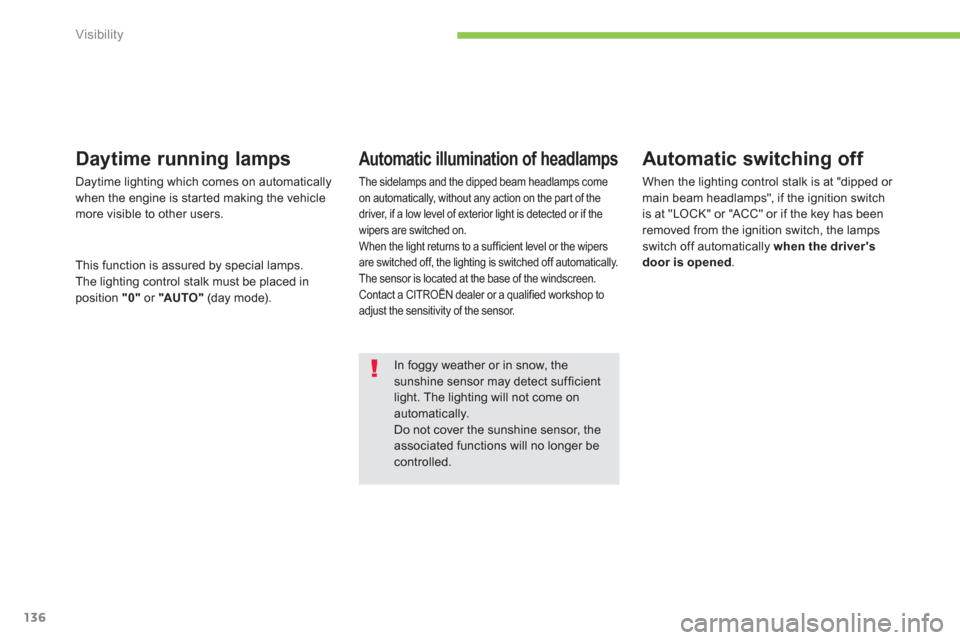
136
Visibility
In foggy weather or in snow, the
sunshine sensor may detect sufficient
light. The lighting will not come on
automatically.
Do not cover the sunshine sensor, the
associated functions will no longer be
controlled.
Automatic switching off
When the lighting control stalk is at "dipped or
main beam headlamps", if the ignition switch
is at "LOCK" or "ACC" or if the key has been
removed from the ignition switch, the lamps
switch off automatically when the driver's
door is opened
.
Daytime running lamps
Daytime lighting which comes on automatically
when the engine is started making the vehicle
more visible to other users.
This function is assured by special lamps.
The lighting control stalk must be placed in
position "0"
or "AUTO "
(day mode).
Automatic illumination of headlamps
The sidelamps and the dipped beam headlamps come
on automatically, without any action on the part of the
driver, if a low level of exterior light is detected or if the
wipers are switched on.
When the light returns to a sufficient level or the wipers
are switched off, the lighting is switched off automatically.
The sensor is located at the base of the windscreen.
Contact a CITROËN dealer or a qualified workshop to
adjust the sensitivity of the sensor.